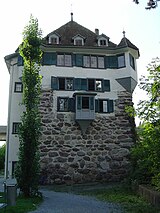Letzigraben
The Letzigraben is now a street in the west of the city of Zurich . It leads from the Letzigrund uphill to the slopes of the Uetliberg and thus follows the earlier course of the Letzimauer , which was an outbuilding of the earlier city fortifications of the Reichsvogtei Zurich and at that time lay far outside the actual city wall .
This line of defense led from the Hardturm on the left bank of the Limmat to the ruins of Friesenberg , which lies on the slopes of the Uetliberg. It was created in the Middle Ages . In Zurich, the Letzimauer was probably also paired with a moat, which should ultimately have given the street its name. The Letzistrasse still reminds of the extension of this defensive line to the Zürichberg on the right side of the Limmat .
Roman manor
From the 1st to the 4th century AD, a Roman estate stood on the Letzigraben, on the same moraine hill as the Zurich gallows later on. The main building was 40 meters long and was first examined by the Antiquarian Society during excavations in 1838. At that time, numerous Roman objects were found, which can now be viewed in the State Museum .
Gallows on the Letzigraben
A gallows erected by the city of Zurich also stood on the Letzigraben from the 14th century . This was located on a moraine hill and was then outside the city. This was where convicts were hung or whacked after they had been tried in the town hall. The people who appeared in droves on the Letzigraben on the day of execution were entertained at food stands.
Today the gallows hill belongs to the area of the Letzigraben open-air swimming pool , which was built in 1947-49 by the architect Max Frisch .
The last execution on the Albisried gallows took place in 1810. The homeless Melchior Dürr, a member of a gang of crooks, was "brought from life to death with a rope," as a contemporary source reports. The gallows was broken off in 1831 in a night-and-fog operation by convicts from Oetenbach prison on behalf of the authorities. During the excavations for Roman remains in the 19th century, numerous finds that belonged to the gallows were probably destroyed.
In the years 2005 to 2007, the listed outdoor pool on the Letzigraben was renovated. As part of this renovation work, the city archeology carried out excavations on the moraine hill, the former location of the gallows. The first results were communicated via the media on February 10, 2006. For example, three skeletons of presumably formerly executed people were found just a few dozen centimeters below today's lawn for sunbathing, some with overstretched cervical spine, twisted arms and a shattered skull roof.
Web links
Individual evidence
- ↑ Skeletons discovered in the Letzi outdoor pool ( memento from July 14, 2012 in the web archive archive.today )
- ↑ Tages-Anzeiger
Coordinates: 47 ° 22 '33.2 " N , 8 ° 29' 49.3" E ; CH1903: 679 931 / 247767
